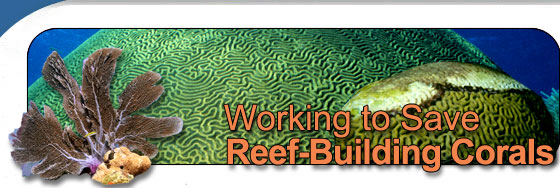Mission Log: September 28, 2007
Marilyn E. Brandt, Ph.D. candidate
University of Miami
This is my mission log, but I warn you, I’m no Captain Kirk. However, I can say that going underwater everyday is a bit like visiting a different world every time. You feel like a stranger in a strange land where you don’t speak the language, and each new coral head holds a new surprise, but it’s all absolutely thrilling. I can’t imagine what a great opportunity it would be to get to live underwater, how astronauts live in space. Today, after finishing our survey dives, I was lucky enough to get to dive with some of the ship’s crew near the Aquarius, the only underwater habitat where scientists can do just that: spend weeks at a time living underwater and studying the coral reef.
 |
|
Sarah Mrozek, the ship's operations officer and my buddy for the dive, next to the Aquarius underwater habitat on Conch Reef in the Florida Keys.
|
I’m a marine biology graduate student at the Rosenstiel School of Marine and Atmospheric Science at the University of Miami, and this is my third time joining the NOAA coral condition and disease cruise aboard the NOAA ship Nancy Foster. On the ship we have to wear close toed shoes all of the time, we have dinner at 4:30, and we get to eat all the chocolate and ice cream we can. Off the ship, we get to see some of the most beautiful reefs in the continental United States.
 |
|
Elkhorn coral (Acropora palmata) providing a nice habitat for fish at Carysfort reef in the Florida Keys.
|
Unfortunately, we’re out here focused on some of the problems facing coral reefs today, specifically the diseases impacting the organisms that actually build the reef, the corals. So far this year the worst culprits seem to be bleaching and black band disease. Coral bleaching occurs when the symbiosis between the coral animal and the microscopic algae that live in their tissue is disrupted because of a stress. The stress can be many things but it’s typically due to extremes of temperature. The corals lose their symbiotic algae or the algae degrade and without the algae to give them color, they turn white (hence the term “bleaching”). The corals are still alive when they’re bleached, but because they rely on their symbiotic algae for part of their energy they can die if they remain bleached for too long. Black band disease is when a thick black mat of microbes, dominated by cyanobacteria, moves across the coral colony dissolving away tissue. It’s not pretty, and a lot of times a large part of the coral head or even the whole colony dies.
 |
|
Black band disease on a boulder star coral (Montastraea faveolata) in the Dry Tortugas. The white is freshly dead coral skeleton.
|
My own research has focused on a different coral disease called white plague. White plague is also a condition where the coral tissue essentially dissolves away, although there’s no black band but just the interface between live tissue and dead skeleton. This disease may be caused by bacteria or by different bacteria on different reefs. Thankfully, we haven’t seen too much of white plague on the reefs during this cruise. For my Ph.D. research I’ve worked to develop a simulation model that investigates the dynamics and impact of white plague on the reef. The model uses data that I’ve collected in the field or that other groups have collected to determine how white plague may be impacting different coral communities today and into the future. It can also help to determine what types of management activities may be the most effective in helping to prevent white plague from changing the structure of a reef. My time on the Nancy Foster during these coral disease cruises has helped me better recognize all of these diseases, and also understand what scientists and managers are interested in learning from models of disease.
 |
|
White plague disease affecting a colony of Meandrina meandrites. The white is freshly dead coral skeleton.
|
Monitoring the condition of corals and the distribution of their diseases can help us understand more about how corals react to and recover from stress. Our actions and other research on coral health and disease will hopefully lead to a day in the future when we’ll be able to diagnose and treat corals like people, and ultimately prevent destructive epidemics. Then maybe we won’t be strangers in a strange land anymore, but allies in the fight to conserve coral reefs for future generations.
|



